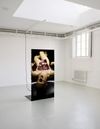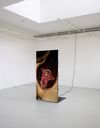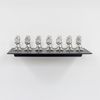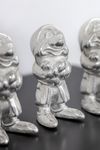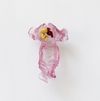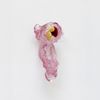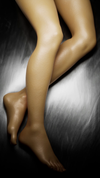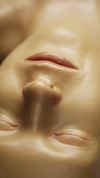Christian Andersen, Frederiksholms Kanal 28A, 1220 Copenhagen K, +45 2537 4101, info@christianandersen.net
Images
Press text
Grumpy, 2025.
CGI animation and recorded audio.
Duration: 2.50 min
The Lily, 2025.
Murano glass, lost wax cast of dissected sexual and reproductive organs, including clitoris and hand made foetus.
18 x 12,3 x 7,4 cm
Grumpy, Grumpy, Grumpy, Grumpy, Grumpy, Grumpy and Grumpy (Silver lining), 2025.
Bronze, lost wax cast, silver coated.
Ed. 3 + 2 AP
11 x 36 x 23 cm
The exhibition Lily features Grumpy (2025), commissioned by and developed in residence for Somerset House Studios, London. Part of the Hyper Functional, Ultra Healthy programme, which explores health and well-being in the face of technological and ecological change. It is available to watch at Channel Sommerset House Studios' online platform following this link (https://www.somersethouse.org.uk/channel/commissions/grumpy).
Acknowledgments:
Arc Justice
Figure Design & 3D Sculpting
James B Stringer
Technical Production Lead
Anonymous, medical artist
Wax casting (Sexual and Reproductive Organs including clitoris)
Prof. Dr. Luc van Nassauw, Senior Researcher / Anatomist and BIOMAB (Biological and Medical Art in Belgium)
Dissection
Sidsel Meineche Hansen’s exhibition Lily inhabits a tense relationship that is at once sculptural, political, biological and cultural. Indeed, it metabolises the distinction between original and copy, as well as the reproduction of desire for consumption, the beautification of death, and the idealisation of womanhood. Hansen’s exquisitely queer feminist practice brings together figures – be they scans, casts or moulds – that persistently recur in different materials and media, as doubled and remediated dummies, customised stock bodies and movements, revenant sex dolls, uncanny ex-votos, or dysfunctional décor. These are haunting assemblages of gender, body, sexuality and class, whose insides and outsides are simultaneously present; whose form, production processes and industries – from the arts to porn, and from entertainment to the military – are duly revealed.
The central focus of the exhibition is Grumpy (2025), a moving-image work presented here for the first time in a gallery space, having previously been accessible online via an intimate, smartphone-based experience (1). It shows adigital, human-like figure lying naked on a metal autopsy table. The framing is geared towards scrutiny, the lighting harsh, and this hairless body is never offered to the gaze in its entirety – only in portions. Over the sound of footsteps that get ominously closer and closer to the scene, the figure seems to be “sleeping dead” while they sing pop tunes and interpellate – sometimes quietly, other times aggressively – a lost lover, embodied melancholically and weirdly by those who look. This defenceless and yet recalcitrant being carries an unborn, tenderly curled-up foetus, visible because her torso has been horrifically cut open, while all the other organs – save for the reproductive ones – have been removed, and the blood has been drained out. Doubly bound by the looped structure of the video, these grotesquely undead creatures inhabit a reality with neither answers nor egresses.
The video is the digital transmogrification of Hansen’s wax sculpture Untitled (Anatomical Venus) (2024), which reboots the misogynist lineage in both the iconography and creation process of a life-size anatomical model known as Venerina (Little Venus, 1782).
Hyper-realistic nudes with removable organs such as those of Venerina became popular in a specific time and place – one that saw theological explanations of the world crumbling when faced with those offered by the natural sciences. With new technologies (e.g. the telescope and the microscope) making it possible to see and to get to know reality, the parameters and aesthetics of medical-artistic representations followed suit. Beauty was thus to be found in the scientifically rigorous and ‘naturalistic’ reproduction of bodies, especially of their innards; hence, dissections of humans became accepted practice despite religious concerns. Surpassing the demand for wax relics of saints and ex-votos, medical waxworks accrued aesthetic and socio-political stigma along the way (2).
In reality, only the cadavers of criminals, suicides, the destitute, or – as in the case of Venerina – unmarried women could be claimed for dissection, often needed by the hundreds just to make one perfect sculpture (3). A singular, idealised body, then, made up of a multitude of other bodies, would have been shaped according to that same myriad of spectral images, stereotyped ideas of womanhood, and standards of beauty ossified in myth and attributed to another empty vessel for patriarchal fantasies and anxieties: the Roman goddess Venus. Moreover, it would have had an alluring, languid expression, would have lasciviously lain on plush fabric as well as, for the most part, would have been pregnant, regardless of the actual state of the original bodies. That form of eviscerated and yet ecstatic beauty was used in the 18th century to encourage the study of anatomy by making death more palatable, and was housed within both public museums of medicine and private collections. Whilst in the 19th century, the anatomical models – then called ‘Slashed Beauties’ or ‘Dissected Graces’ – were morbidly exposed under glass cases at funfairs panopticons together with other prurient waxworks, sensational automata, and racialised individuals with non-conforming bodies who were deemed ‘freaks.’
The women that the Venerina is made of did not give consent for their bodies to become an anatomical model for the public display of sexual and reproductive functions. This was a situation where identity and ownership of one’s narrative and body got lost. Hansen’s Untitled (Anatomical Venus) follows a different path, one that negotiates a way through this problematic lineage with a composite process. The smooth body is a wax cast of a re-sculpted 3D stock model – an invention created entirely for the gaming and porn industry, named EVA v3.0, which Hansen has employed in other works such as DICKGIRL 3D(X) (2016) and Seroquel® (2014). At Hansen’s request, the gnarled sexual and reproductive organs, belonging to a deceased elderly female who had donated her body to science (the foetus is a sci-fi addition), were cast in wax by a medical artist during a dissection. The Lily (2025) continues Hansen’s critical investigation into biological essentialism by re-casting the aforementioned organ, this time in delicate, pink Murano glass, complete with clitoris – it is no surprise that anatomical models do not usually provide a detailed view of the vulva, because female sexual pleasure cannot be sought in reproduction, and in many patriarchal societies it is still considered psychologically incompatible with motherhood. Disembodied and decontextualised, The Lily may resemble a votive offering to a function without identity: the organ that makes gestative labour possible and, historically, the synecdoche for the person who makes social reproduction possible. It also resembles a flower in its appearance, and those versed in Catholic iconography will not miss the connection between the title and the flower customarily donated by the Archangel Gabriel to Mary upon the announcement of her virginal pregnancy. Besides, the transparency of glass echoes many concerns addressed by Hansen’s research, such as the voyeuristic fetishisation of the insides of the female body, and in vitro fertilisation (IVF), but also, in other works, the all-encompassing surveillance culture that tries to make people as transparent as their data, making space for what the process represses, i.e. flesh and its decay.
This is not the first time that Hansen has created casts of individual body parts in an effort to dislodge the heteronormative view on reproduction by creating an open-ended plane where forms and subjectivities are fundamentally unstable. For example, Baby Mould (2023) is the crystal-glass cast of a fifteen-part terracotta mould for sculptures depicting the infant Jesus. It looks like a transparent womb or a crib, but it is unwelcomingly presented upside down. Nominally as much as materially, Baby Mould capsizes the matrix of a cast, which is otherwise called the ‘mother mould.’ The inspiration, once again, came from a sculpture, this time seen during an encounter with the congregation of the Little Sisters of Jesus. Hansen and their long-term collaborator Therese Henningsen met them in London to make Baby Jesus (2023), a documentary focusing on the sisters’ way of life, which must comply with vows of chastity, poverty, and obedience. When one of them, Little Sister Katarzyna Barbara of Jesus, is not restocking supermarket shelves, she produces clay sculptures of the baby Jesus with various dimensions and in different poses, which are then sold. Here, non-biological baby-making melts with commodity-making.
In this murky – when not straightforwardly perverse – capitalist and libidinal loop of potentially infinite reproduction, the Grumpy, Grumpy, Grumpy, Grumpy, Grumpy, Grumpy, and Grumpy (Silver Lining) (2025) miniatures on the low shelf replicate the nominal character – the ‘woman-hater’ as per Walt Disney – of Snow White and the Seven Dwarfs (1937) (4). Disney’s first feature-length animated film (and, incidentally, one of Adolf Hitler’s favourite movies) replicated ableist and sexist stereotypes of the time vis-à-vis people with dwarfism as providers of entertainment only – one of the last examples of the fading culture of freak shows (5) – but also vis-à- vis women as beautiful, fragile objects without agency, that need to be put under glass. Across this exhibition, which is named after Hansen’s beloved daughter, the figurative, affective, and semantic worlds of Grumpy have served as the ‘ghosts in the machine’ of different materials, media and works. Here, the artist has concealed neither the horror of death nor the brutality of dissection, nor have they deflected the vulnerability of unconscious states or the violence that can be conveyed through cartoonish aesthetics. Could this clarity in dealing with the cultural spectres of patriarchy be today’s most necessary silver lining?
Text by Bianca Stoppani
(1). Grumpy (2025) was commissioned and produced by Somerset House Studios and is available to watch at https://www.somersethouse.org.uk/channel/commissions/grumpy. For a detailed analysis of Grumpy (2025) and the implication of experiencing it on a smartphone, see Bianca Stoppani, “Never Let Go”, Flash Art International, Issue 351, Summer 2025, https://flash---art.com/article/sidsel-meineche-hansen/#.
(2). Joanna Ebenstein, The Anatomical Venus: Wax, God, Death & the Ecstatic (Thames & Hudson, 2016), 107.
(3). Ernst Hausner, The Pathological-Anatomical Collection in the Narrenturm at the Old General Hospital, trans. Gertrude Maurer (Edition Hausner, 2016), 9.
(4). “Snow White and the Seven Dwarfs - 1937 Original Theatrical Trailer,” posted March 18, 2022, by Animation Compendia, YouTube, 01:39, https://www.youtube.com/watch?v=CcWD5hI44WI.
(5). Erin Pritchard and Robert Kruse, “Cultural Representations of Dwarfism,” Journal of Literary & Cultural Disability Studies 14.2 (2020): 133, https://doi.org/10.3828/jlcds.2020.6.
The gallery thanks Fake Foundation for their generous contribution to the LED screen.


